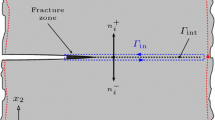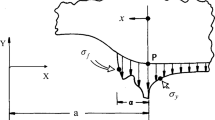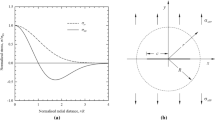Abstract
The strip yield model of Dugdale and Bilby, Cottrell and Swinden is applied to analyse the incubation and growth of creep cracks. This extends previous work by Vitek (on incubation) and by Heaton and Chan (following To) on growth.
Following both Vitek and Heaton and Chan, the main criterion of crack growth used is a COD-based one. The crack is assumed to grow at constant crack opening displacement (COD) φ=φc and the creep strain ∈t at the crack tip is assumed to be φ/h, where the gauge length is a material constant.
The COD-based theory indicates that the incubation and failure timest i,t fare controlled by the stress intensity factorK at large stresses, but by the net stress at very low stresses. A weakness of the theory is that it neglects primary-creep effects: these have to be absorbed by modifying the secondary-creep index. If this is done, then comparison with two independent experiments shows moderately good agreement with the COD-based theory for botht iandt f.
Résumé
Le modèle d'écoulement plastique d'une bande proposée par Dugdale et Bilby, Cottrell et Swinden a été appliquée à l'analyse de l'incubation et de la croissance des fissures de fluage. Ce travail constitue une extension d'un travail précédent par Vitek (sur l'incubation) et par Heaton et Chan (d'après To) sur la croissance. En suivant Vitek et Heaton et Chan, le critère principal de croissance de la fissure utilisé est un critère basé sur le COD. On suppose que la fissure augmente à une valeur constante du COD (φ=φc) et que la déformation de fluage ∈t à l'extrémité de la fissure est φ/h pour une longueur de référence considérée comme une constante du matériau. La théorie basée sur le COD indique que les temps d'incubationt iet de rupturet fsont contrôlés par le facteur d'intensité des contraintesK à des contraintes élevées et par la contrainte nette à des contraintes très faibles. Une faiblesse de la théorie réside dans ce qu'elle néglige les effets du fluage primaire; ces effets doivent être absorbés en modifiant l'index relatif au fluage secondaire. Si cette opération est réalisée, la comparaison de deux expériences effectuées indépendamment l'une de l'autre montre un accord raisonnablement bon avec la théorie basée sur le COD, aussi bien dans le cas det ique dans le cas det f.
Similar content being viewed by others
References
M.J. Siverns and A.T. Price,Nature, 228 (1970) 760–761.
R.D. Nicholson and C.L. Formby,International Journal of Fracture, 11 (1975) 595–604.
V. Vitek,International Journal of Fracture, 13 (1977).
M.J. Heaton and R. Chan, A simple model for creep crack growth, private communication (1976).
K.C. To,International Journal of Fracture, 11 (1975) 641–648.
K.C. To,International Journal of Pressure Vessels and Piping, 4 (1976) 63–83.
A.D. Batte, The initiation and growth of creep cracks in 1% CrMoV rotor forging material, private communication (1975).
J.R. Haigh,Materials Science and Engineering, 20 (1975) 213–224.
D.S. Dugdale,Journal of Mechanics and Physics of Solids, 8 (1960) 100–104.
B.A. Bilby, A.H. Cottrell and K.H. Swinden,Proceedings of the Royal Society, A 727 (1963) 304–314.
L.M. Kachanov, “Rupture time under creep conditions”, article inProblems of continuum mechanics: contributions in honor of the seventieth birthday of N.I. Muskhelishvili, ed. J.R.M. Radok, Philadelphia (1970) 202–218.
P.T. Heald, G.M. Spink and P.J. Worthington,Materials Science and Engineering, 10 (1972) 129–138.
A.R. Dowling and C.H.A. Townley,International Journal of Pressure Vessels and Piping, 3 (1975) 77–107.
G.R. Irwin, “Fracture”, article inEncyclopaedia of Physics, Vol. 6, ed. S. Flügge, Springer-Verlag,Berlin (1958) 551–590.
G.D. Branch, J.B. Marriott and M.C. Murphy,International Conference on Properties of Creepresistant Steels, Dusseldorf (1972) Paper 7.1.
Author information
Authors and Affiliations
Rights and permissions
About this article
Cite this article
Ewing, D.J.F. Strip yield models of creep crack incubation and growth. Int J Fract 14, 101–117 (1978). https://doi.org/10.1007/BF00032388
Received:
Issue Date:
DOI: https://doi.org/10.1007/BF00032388




